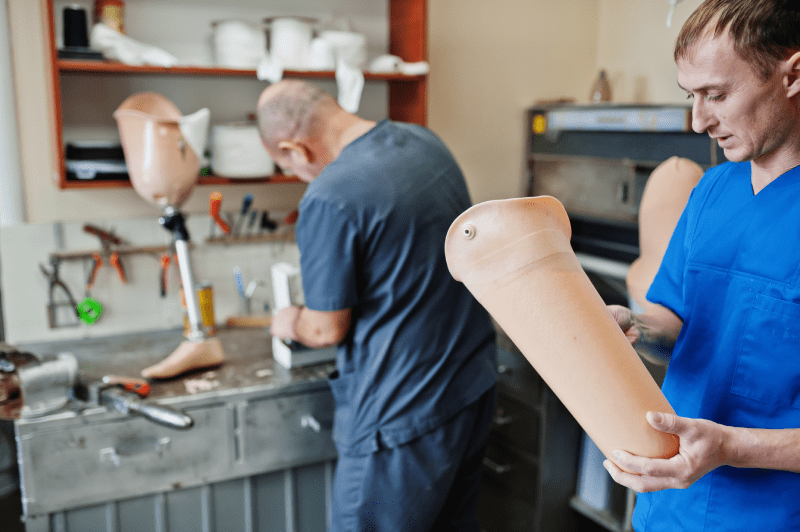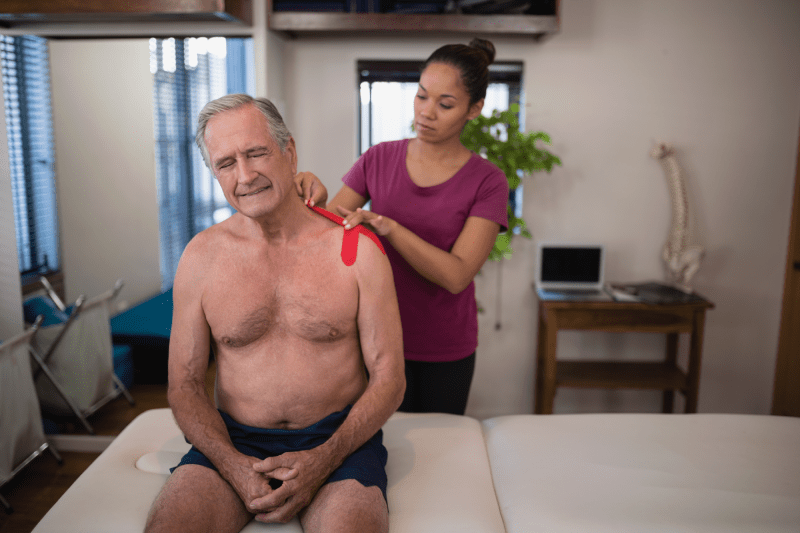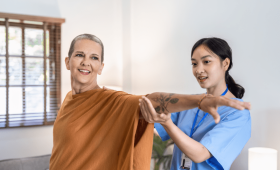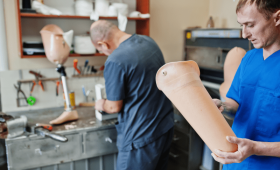What is a Traditional Shoulder Replacement?
A traditional shoulder replacement is a surgical procedure for patients with shoulder arthritis (osteoarthritis) or joint damage. In this operation, the head of the humerus (upper arm bone) and the glenoid surface of the scapula (shoulder blade) are replaced with artificial components. The prosthetic parts are designed to provide a smooth joint surface and eliminate pain. This surgery is preferred in cases where the joint cartilage is severely damaged but the rotator cuff muscles are still intact.
What is a Reverse Shoulder Replacement?
A reverse shoulder replacement, unlike a traditional prosthesis, is a surgical procedure where the ball and socket positions are reversed. In this technique, the socket component is placed on the humerus head, and the ball component is placed on the glenoid surface of the scapula. This method is especially preferred in cases of severe tears in the rotator cuff muscles or when previous shoulder surgeries have been unsuccessful. The reverse prosthesis allows the deltoid muscle to move the shoulder, thus solving problems caused by the non-functioning rotator cuff.
When is a Traditional Shoulder Replacement Preferred?
A traditional shoulder replacement is usually preferred in cases where the joint cartilage is severely worn out due to diseases such as shoulder arthritis (osteoarthritis) or rheumatoid arthritis. The most important condition for this operation is that the rotator cuff muscles, which stabilize and move the shoulder joint, are healthy and functional. When these muscles are intact, the patient can easily move their arm after surgery and joint pain is relieved.
When is a Reverse Shoulder Replacement Preferred?
A reverse shoulder replacement is typically used in patients with large, irreparable tears in the rotator cuff muscles, a condition known as rotator cuff arthropathy. It is also preferred in cases where previous shoulder replacement surgeries have failed, joint fractures are multi-fragmented, or there is severe muscle damage. The reverse prosthesis compensates for the function of the damaged rotator cuff by using the deltoid muscle, restoring shoulder movement.
What Factors Affect the Cost of the Surgery?
The cost of a shoulder replacement surgery in Turkey varies depending on many factors. The most important of these factors are the type of prosthesis to be used (traditional or reverse), the experience and reputation of the surgeon performing the operation, the quality of the hospital where the operation will be performed, the level of technological equipment, and the difficulty of the operation. Additionally, the patient’s condition and additional health problems can also affect the cost. Prices are quite competitive compared to Western countries.
Why Are Prices in Turkey More Affordable?
The main reasons why shoulder replacement surgeries are more affordable in Turkey include a lower exchange rate compared to Western countries and a lower general cost of living. In addition, intense competition in the field of medical tourism encourages clinics and hospitals to offer more competitive prices. Providing affordable services without compromising on quality makes Turkey an attractive destination for medical tourism.
What Do All-Inclusive Packages Include?
Hospitals in Turkey generally offer “all-inclusive” packages for international patients. These packages may include the surgery fee, the duration of hospital stay (usually 2-3 days), anesthesia, necessary pre- and post-operative tests, medications, dressing materials, physiotherapy sessions, and airport transfer services. Some packages may also include accommodation services. These packages ensure that patients can complete their travel and treatment processes smoothly.
What is the Cost Difference Between a Traditional and Reverse Prosthesis?
There is usually a cost difference between traditional and reverse shoulder prostheses. A reverse shoulder prosthesis can be more expensive than a traditional one due to the more complex surgical procedure it requires and the more specialized prosthetic material. The reverse prosthesis has a more specialized structure designed to allow the deltoid muscle to move the shoulder, which increases its production cost. Therefore, it is important to discuss this issue in detail with your surgeon before the surgery.
What is the Lifespan of a Traditional Shoulder Prosthesis?
The lifespan of a traditional shoulder prosthesis depends on the quality of the material used, the patient’s lifestyle, and their level of physical activity. A traditional shoulder prosthesis can generally last for 15-20 years or longer. To extend the life of the prosthesis, it is important to follow the doctor’s recommendations in the post-operative period, avoid activities that put excessive strain on the shoulder, and exercise regularly. In rare cases, revision surgery may be necessary due to loosening or wear of the prosthesis.

What is the Lifespan of a Reverse Shoulder Prosthesis?
Although reverse shoulder prostheses are a newer technology than traditional ones, research shows that they are long-lasting. The lifespan of reverse prostheses can also be 10-15 years or more. Since they operate under more stress than traditional prostheses, they may have a higher potential for faster wear. However, thanks to high-quality materials and advanced surgical techniques used today, their lifespan has been significantly extended.
Who is the Most Suitable Candidate for the Surgery?
The most suitable candidate for shoulder replacement surgery is a person who has severe pain, limited range of motion, and loss of joint function in the shoulder joint. The candidate’s general health should be at a level to withstand the surgery, and they should not have any infections. Your surgeon will decide which type of prosthesis is most suitable for you based on a physical examination and imaging results (X-ray, MRI).
What Tests Are Required Before the Surgery?
Before shoulder replacement surgery, a series of tests are performed to evaluate your general health. These tests generally include a blood test, chest X-ray, EKG, and an MRI or CT scan to get a detailed image of the shoulder. These tests are necessary to determine if you are suitable for the surgery and to minimize potential risks. Most all-inclusive packages cover these tests, so patients do not need to get tested elsewhere.
How Long Does the Post-operative Recovery Process Take?
The post-operative recovery process after a shoulder replacement surgery varies depending on the surgical technique and the patient’s general health. The hospital stay is usually 2-3 days. It is important to rest and protect the shoulder for the first few weeks. Physical therapy is the most critical part of the recovery process and usually begins a few days after the surgery. It may take 6-12 months for the arm to return to normal function.
Why is Post-operative Physiotherapy Important?
Physiotherapy is a vital part of the recovery process after a shoulder replacement surgery. A physical therapist determines specific exercises that will help you regain range of motion, rebuild muscle strength, and reduce pain in the operated shoulder. Regular physiotherapy sessions ensure the longevity of the prosthesis and the patient’s return to daily activities.
Will There Be a Limited Range of Motion After a Traditional Prosthesis Surgery?
Traditional shoulder replacement surgery aims to reduce pain and improve shoulder movement. With post-operative physiotherapy, patients can usually raise their arm to head level. However, the limited range of motion that existed before the surgery may not completely disappear. Your surgeon will realistically evaluate your expectations before the surgery. Regular exercise after surgery is very important to increase the range of motion.
Will There Be a Limited Range of Motion After a Reverse Prosthesis Surgery?
A reverse shoulder replacement is designed for patients who cannot lift their arm, especially because their rotator cuff muscles are non-functional. Thanks to this surgery, patients can lift their arms to head level by using their deltoid muscle. However, some movements (e.g., rotating the arm backwards) may remain limited compared to a traditional prosthesis. The purpose of the surgery is to provide a sufficient range of motion to perform basic daily activities.
How Long Does Post-operative Pain Last?
Post-operative pain is most intense in the first few days after the surgery. However, this pain can be easily controlled with the painkillers that your surgeon will prescribe. The pain usually decreases within a few weeks. Regular physical therapy and following the surgeon’s recommendations help the pain subside faster. In the long term, the chronic pain experienced before the surgery disappears.
When Can I Travel by Plane After the Surgery?
After shoulder replacement surgery, a surgeon’s approval is usually required to travel by plane. Most patients can travel by plane 1-2 weeks after the surgery. However, it is important to protect the shoulder and not keep it in a fixed position for a long time during the flight. It may be beneficial to drink plenty of fluids and take small walks to increase blood circulation before and during the flight.
When Can I Wear Glasses After the Surgery?
Shoulder replacement surgery is not expected to directly affect the eyes. However, it is important to avoid lying on your stomach and putting pressure on the operated shoulder in the post-operative period. Therefore, there are no specific restrictions on wearing glasses.
How to Find the Best Hospital or Clinic?
It is important to do comprehensive research to find the best hospital or clinic. Prefer hospitals with international accreditations such as JCI. Check the surgeon’s experience and expertise in this field. Examine the reviews and results of previous patients. Getting consultations from more than one clinic to compare will help you make the right decision.
What is the Difference Between Traditional and Reverse Prosthesis Surgery?
The most fundamental difference between traditional and reverse shoulder replacement surgeries is the type of prosthesis used and how they are placed in the shoulder joint. In a traditional prosthesis, the natural ball-and-socket structure of the joint is preserved, while in a reverse prosthesis, this structure is reversed. A traditional prosthesis is ideal for patients with intact rotator cuff muscles, while a reverse prosthesis is ideal for those with damaged or non-functional rotator cuff muscles. These differences also affect the indications, surgical technique, and recovery process of both surgeries.
How High is the Long-Term Success of the Surgery?
The long-term success of shoulder replacement surgery depends on the right patient selection and the skill of an experienced surgeon. Traditional shoulder prostheses have a success rate of over 90% for suitable patients and largely eliminate pain. Reverse shoulder prostheses, on the other hand, are very successful in restoring the ability to lift the arm in suitable patients, and patient satisfaction is high.
Are There Any Risks of Post-operative Complications?
As with any surgical operation, there are some risks associated with shoulder replacement surgery. These risks include infection, bleeding, nerve damage, dislocation or loosening of the prosthesis. However, these risks are quite low thanks to modern surgical techniques and hospital conditions. Working with an experienced surgeon and following the doctor’s instructions after the surgery minimizes the risks.
When is Revision Surgery Needed?
Revision surgery for a shoulder prosthesis may be necessary in cases where the prosthesis has reached the end of its lifespan, loosened, dislocated, become infected, or when tissue damage has occurred around the prosthesis. Wear and tear of the prosthesis after many years since the first surgery is also a reason for revision. Revision surgeries are more complex and challenging than the first surgery.
How Experienced Are the Hospitals and Surgeons in Turkey?
Turkey has become an important center for medical tourism and has very experienced surgeons and modern hospitals for shoulder replacement surgery. Turkish surgeons have been trained according to international standards and have performed thousands of successful operations. Before the surgery, it is important to check the surgeon’s experience and references in this field.
Will There Be a Permanent Scar After a Shoulder Replacement Surgery?
It is normal for a surgical scar to remain on the operated shoulder after shoulder replacement surgery. Depending on the type of surgery and the surgeon’s technique, the size and appearance of the scar vary. These scars fade over time and become less noticeable with the healing process. Wound care and sun protection during the healing process help the scars look better.
When Can I Drive a Car After the Surgery?
It is generally recommended to wait 6-8 weeks to drive a car after shoulder replacement surgery. This period is necessary for the shoulder to heal sufficiently and to regain the muscle strength to hold the steering wheel safely. Before you start driving, you should make sure that you can move your arm comfortably and do not feel any pain.
Are Physiotherapy Sessions Included in the Package Price?
Some “all-inclusive” packages may include a certain number of post-operative physiotherapy sessions. However, not all packages may have this service. It is important to clarify this detail with the clinic when planning your surgery. Since long-term physiotherapy will be required, it is important to find out whether the cost of these sessions is included in the package.
How Long Should I Plan to Stay for the Surgery?
You may generally need to stay in Turkey for 1-2 weeks for a shoulder replacement surgery. This period covers the surgery, hospital stay, and early-stage physiotherapy sessions. Detailed planning with your surgeon before the surgery ensures that your trip goes smoothly.

Which is Longer Lasting, a Traditional or a Reverse Prosthesis?
The lifespan of prostheses varies depending on the patient’s lifestyle and activity level. Traditional prostheses are exposed to less stress because the rotator cuff muscles are intact, and therefore they can generally be longer-lasting. Reverse prostheses, on the other hand, may have a higher potential for faster wear because they work with more complex mechanisms. However, both prostheses are designed to last for many years.
What is the Patient’s Role in the Success of the Surgery?
The patient’s role in the success of the surgery is very large. Strictly following the surgeon’s instructions, not skipping physiotherapy sessions, avoiding strenuous activities, and adopting a healthy lifestyle speed up the recovery process and extend the life of the prosthesis. The patient’s motivation and commitment to the post-operative period determine the quality of the final outcome.
What Should I Pay Attention to in Clothing During the Recovery Process?
During the recovery process, it is best to wear clothes that are easy to get on and off, such as wide, buttoned or zippered shirts. Since dressing and undressing may be difficult in the first few weeks, it is important to choose practical clothes. Your surgeon will give you specific instructions on how to move the operated arm.
When is Physical Activity Possible After the Surgery?
After the surgery, light physical activities (like walking) can be started a few days after the operation. For sports that put a load on the shoulder, such as swimming, golf, or tennis, it is generally necessary to wait 3-6 months. It is recommended to start heavy sports and muscle building after 6 months.
What Are the Additional Services for Patients Coming from Abroad?
Additional services for patients coming from abroad include not only the surgical packages but also travel and accommodation arrangements. These services include airport pickup, hospital and hotel transfers, translation services, and accommodation arrangements. These services make patients feel safer and more comfortable in a foreign country.
Can the Outcome of the Surgery Be Guaranteed?
No surgical operation can be guaranteed 100%. The success of a shoulder replacement surgery depends on many factors such as the surgeon’s experience, the patient’s general health, and their commitment to the rehabilitation process. However, working with an experienced and successful surgeon significantly increases the probability of achieving the desired outcome. Your surgeon will realistically evaluate your expectations before the surgery and provide information about the potential outcomes.
Is a Prosthesis Needed in Cases Without Cartilage Damage?
If there is no cartilage damage but there is pain and limited range of motion in the shoulder, shoulder replacement surgery is usually not the first option. In these cases, less invasive methods such as physical therapy, medication, or shoulder arthroscopy may be preferred. A shoulder prosthesis is generally considered when there is advanced arthritis or irreversible damage to the joint.
How Much Does a Reverse Shoulder Prosthesis Feel Different from a Traditional One?
Since a reverse shoulder prosthesis changes the ball-and-socket structure of the joint, patients may feel the movement of the shoulder differently after the surgery. Due to the deltoid muscle moving the shoulder, the lifting motion of the arm, in particular, becomes easier and more controlled. However, some patients may have difficulty getting used to this new movement mechanism. Physical therapy helps with this process.



